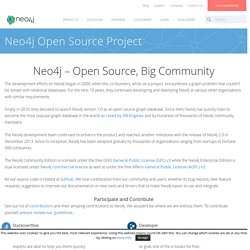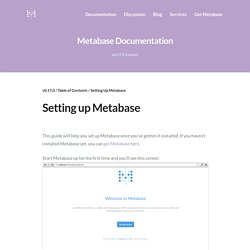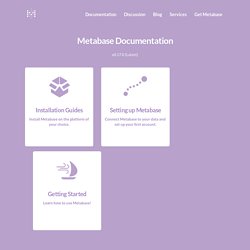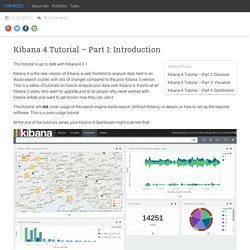

Image In Network Shop - boutique pour les pros de l'audio-video - Image In Network shop. Analytics Customer Success Stories - Google Analytics Solutions – Google. Datasets. A query language for your API. Vertica Big Data SQL Analytics Platform Free Software & Trials. Base de données orientée graphe. Un article de Wikipédia, l'encyclopédie libre.

Une base de données orientée graphe est une base de données orientée objet utilisant la théorie des graphes, donc avec des nœuds et des arcs, permettant de représenter et stocker les données. Qu'est ce qu'une base de données orientée graphe ? [modifier | modifier le code] Par définition, une base de données orientée graphe correspond à un système de stockage capable de fournir une adjacence entre éléments voisins : chaque voisin d'une entité est accessible grâce à un pointeur physique. Participate & Contribute in the Neo4j Open Source Project. The development efforts on Neo4j began in 2000, when the co-founders, while on a project, encountered a graph problem that couldn’t be solved with relational databases.

For the next 10 years, they continued developing and deploying Neo4j at various other organizations with similar requirements. Finally in 2010, they decided to launch Neo4j version 1.0 as an open source graph database. Since then, Neo4j has quickly risen to become the most popular graph database in the world as rated by DB-Engines and by hundreds of thousands of Neo4j community members. The Neo4j development team continued to enhance the product and reached another milestone with the release of Neo4j 2.0 in December 2013. Since its inception, Neo4j has been adopted globally by thousands of organizations ranging from startups to Fortune 500 companies. All our source code is hosted at GitHub. Participate and Contribute.
Pinterest. Erlang Programming Language. Elixir. Elixir (langage de programmation) Un article de Wikipédia, l'encyclopédie libre.

Filter out data to the mobile. Metabase. Setting Up Metabase. v0.17.0 / Table of Contents / Setting Up Metabase This guide will help you set up Metabase once you’ve gotten it installed.

If you haven’t installed Metabase yet, you can get Metabase here. Start Metabase up for the first time and you’ll see this screen: Go ahead and click Let’s get started. Setting up an admin account The first thing you’ll need to do is set up an admin account. For now, let’s just create an account for ourselves to explore Metabase. Gathering your database info At this point you’ll need to gather some information about the database you want to use with Metabase. If you’re ready to connect, here’s what you’ll need: The hostname of the server where your database lives The port the database server uses The database name The username you use for the database The password you use for the database. README.
v0.17.0 / Table of Contents In-depth Guides Users Guide This is the go-to guide on asking questions and sharing answers using Metabase.

You’ll learn in depth about how questions are expressed, how to chart answers, as well as how to share questions and create dashboards. Liste des outils repérés par la communauté des journalistes. OpenToonz. OpenTSDB - A Distributed, Scalable Monitoring System. La boite à outils du veilleur 2.0. Introduction à ELK : Elasticsearch, Logstash et Kibana - Wooster. Présentation de ELK, pile logicielle composée de Elasticsearch, Logstash et Kibana pour la gestion des logs.

J’ai commencé à suivre Logstash en 2011 et le moins que l’on puisse dire, c’est qu’il a fait un sacré bonhomme de chemin. Il faut dire que hormis SEC, il n’y avait pas grand chose de disponible dans le monde Open Source pour ce genre de travail. Et puis le rapprochement naturel qui s’est opéré avec Elasticsearch et Kibana amène aujourd’hui le projet vers de nouvelles ambitions. Devenir une des pierres angulaires de la Business Intelligence… Rien moins que ça ! Il faut dire que Logstash est désormais bien entouré. Kibana User Guide [4.0] Kibana 4 Tutorial – Part 1: Introduction » Tim Roes.
This tutorial is up to date with Kibana 4.0.1.

Kibana 4 is the new version of Kibana, a web frontend to analyze data held in an elasticsearch cluster, with lots of changes compared to the prior Kibana 3 version. This is a series of tutorials on how to analyze your data with Kibana 4. It aims at all Kibana 3 users, who want to upgrade and at all people who never worked with Kibana before and want to get known how they can use it. This tutorial will not cover usage of the search engine elasticsearch (without Kibana) or details on how to set up the required software. This is a pure usage tutorial. At the end of the tutorials series, your Kibana 4 Dashboard might look like that: Set up a test environment If you have an elasticsearch running and want to use it, you can just download the latest Kibana 4 and install it.
Sample data If you use the provided Kibana 4 vagrant machine, you will have the same sample data, we use throughout the tutorials. Setting your index(es)